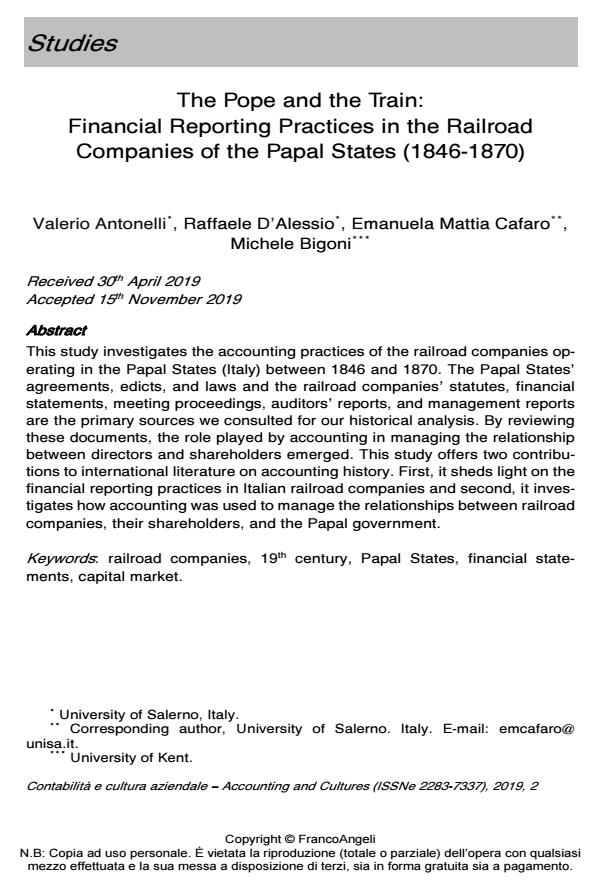The Pope and the Train: Financial Reporting Practices in the Railroad Companies of the Papal States (1846-1870)
Titolo Rivista CONTABILITÀ E CULTURA AZIENDALE
Autori/Curatori Valerio Antonelli, Raffaele D’Alessio, Emanuela Mattia Cafaro, Michele Bigoni
Anno di pubblicazione 2020 Fascicolo 2019/2
Lingua Inglese Numero pagine 28 P. 7-34 Dimensione file 349 KB
DOI 10.3280/CCA2019-002002
Il DOI è il codice a barre della proprietà intellettuale: per saperne di più
clicca qui
Qui sotto puoi vedere in anteprima la prima pagina di questo articolo.
Se questo articolo ti interessa, lo puoi acquistare (e scaricare in formato pdf) seguendo le facili indicazioni per acquistare il download credit. Acquista Download Credits per scaricare questo Articolo in formato PDF

FrancoAngeli è membro della Publishers International Linking Association, Inc (PILA)associazione indipendente e non profit per facilitare (attraverso i servizi tecnologici implementati da CrossRef.org) l’accesso degli studiosi ai contenuti digitali nelle pubblicazioni professionali e scientifiche
This study investigates the accounting practices of the railroad companies operating in the Papal States (Italy) between 1846 and 1870. The Papal States’ agreements, edicts, and laws and the railroad companies’ statutes, financial statements, meeting proceedings, auditors’ reports, and management reports are the primary sources we consulted for our historical analysis. By reviewing these documents, the role played by accounting in managing the relationship between directors and shareholders emerged. This study offers two contributions to international literature on accounting history. First, it sheds light on the financial reporting practices in Italian railroad companies and second, it investigates how accounting was used to manage the relationships between railroad companies, their shareholders, and the Papal government.
Parole chiave:Railroad companies, 19th century, Papal States, financial statements, capital market.
- Successes and crises in the joint-stock rail company Ferrovie Elettriche Abruzzesi (1929-1956) Antonio D’Andreamatteo, Francesca Neri, Massimo Sargiacomo, in CONTABILITÀ E CULTURA AZIENDALE 1/2023 pp.61
DOI: 10.3280/CCA2023-001004
Valerio Antonelli, Raffaele D’Alessio, Emanuela Mattia Cafaro, Michele Bigoni, The Pope and the Train: Financial Reporting Practices in the Railroad Companies of the Papal States (1846-1870) in "CONTABILITÀ E CULTURA AZIENDALE" 2/2019, pp 7-34, DOI: 10.3280/CCA2019-002002